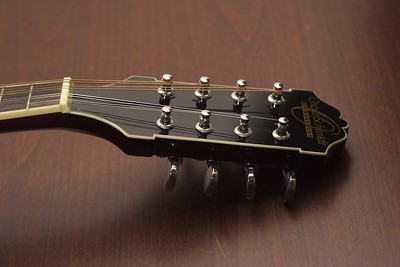Tuning a mandolin is a pain we all know that but it doesn’t have to be. We want this article to be your guiding light on how to tune your mandolin easily to sound perfect every time you start to play.
There are different methods to tuning which you will learn. Pick one that suits you the best and let’s get into learning how to tune.
If you want just a quick video guide then the video below is the best one out there.
Table of Contents
- 4 Methods To Tuning a Mandolin
- Why Do We Need To Tune a Mandolin
- How Often Should You Tune a Mandolin?
- Should You Tune Mandolin Styles Differently?
- Conclusion
4 Methods To Tuning a Mandolin
First off, prior to turning a tuning peg, play a string to be sure that the peg you are altering correct and in the right direction. Always tune a string beginning with the pitch below the targeted tuning, then tune-up to the pitch you aim.
The reason for not starting with a higher pitch than intended is because that would cause the string to overstretch to the point of snapping, and also, the string may go out of tune faster.
#1 Tuning Using Electrical Mandolin Tuners
Pluck and let each string until it virtually matches the note on the tuner. The cable will come up the center, or the light turns green when it matches correctly. Here, as usually happen, in case one of the string is out of tune, the whole pair falls out.
To solve this problem, isolate each pair using the rest stroke. Using a G string, for instance, hit the top G string and allow it to rest on the lower G string. After the top g string is in tune, pull the other initially lower G string and let to rest on the top G. That’s the only way to ear the individual strings.
Repeat the process with the other strings until they are all in tunes. Then check your octaves as you play both low and high versions of the same note, to know if you are in tone.
Keep checking and adjusting the octaves to achieve the perfect sound. Also, be careful as you tune as you inspect the 12th fret, which is in the middle of both the bridge and nuts. The harmonics on the 12th fret should sound precisely an octave above the unfretted note version.
#2 Tuning a Mandolin by Ear
Only if you a rare perfect experienced mandolinist with a perfect pitch to be able to tune the instrument without the reference, you must have an external reference point.
Like everyone will need a reference like a piano or a tuner to achieve an ideal pitch.
Even if you are a genius tune, if you have the phone app, a guitar, or a piano nearby, refer when tuning a G string.
- Play G string on your reference source, then play the same on your mandolin. If your instrument sounds higher, tune it to a lower, and the reverse is true.
- Repeat the same process as many times as possible until your mandolin Gstring achieves exactly similar sound as the reference source.
- After the reference source is in tune or unison with the G strings sound, you can tune the rest of the strings using the mandolin.
- Start by playing your D string as you refer to the G string, and when their sound matches, move to the other strings.
- As you repeat the process, always use the 7th fret until their relationship is perfectly identical.
- Finally, double-check after finishing, and if all is in tune, move on.
#3 Tuning Your Mandolin To Itself/String
- Let the instrument rest on your lap in the playing position with E; the first string, most close to the wall in the order E(1) A(2) D(3) G(4).
- Place your left index finger on A or 2nd string, which is in the 7th fret of a mandolin, and let it make a similar sound to the 1st string played unfretted.
- Place your left index at the 7th fret on the D string and tune it till it sounds exactly similar to the A string played unfretted.
- Repeat the same process by placing the left index finger on the 4th string at the 7th fret and make the string produce similar sound to D string played unfretted.
- Check twice to ensure that no alteration affected the final output since mandolins tend to go out of tune as each string has an impact on the tension of other strings.
#4 Tuning Your Mandolin With a Guitar Tuner
Most standard guitar tuners can tune a mandolin since they can recognize the pitch irrespective of the octave as long as you follow basic principles.
Usually, apart from the G string, other upper mandolin strings have high pitches, which some times struggle the guitar tuners from recognizing them perfectly.
Therefore, it is recommendable to tune lower strings using the guitar tuners then; the rest ear tuning can help.
Why Do We Need To Tune a Mandolin
Tuning a mandolin is something crucial that you will need to understand before you officially start training on how to play the instrument. If you train with a mandolin that is not in tune, no matter how your trainer is skilled, it will never sound good.
You should know that all fretted instruments will definitely fall out of tune. However, there is nothing to worry about, as after you master tuning, that will live in your mind.
How Often Should You Tune a Mandolin?

How often a mandolin will need tuning depends on the temperature of the surrounding in which the instrument played, string stretch, and humidity level. Those three factors may cause the woods to either contract or expand.
This may change the tension of the string and, ultimately, the tuning. For this reason, a mandolin sometimes requires to be tuned anytime you pick it up or after playing for like 30 minutes continuously.
Should You Tune Mandolin Styles Differently?
Well, contrary to popular belief, all typical mandolin styles, whether F-style or A-style with F or Oval hole, are tuned GDAE (Standard Mandolin Tuning ) from large string (top string) to bottom.
Mandolins may have varied scale length that is the distance between the bridge and nut. The scale length is the factor that determines how long a vibrating string will be.
Longer vibrating strings require more tension to achieve the pitch expected. Therefore, even if you have mandolins with different string lengths, they will still be tuned the same.
Conclusion
Finally, with the above explanation , even if you are a beginner mandolin learner, followed the information on this article will prepare you adequately to face the next step.
A mandolin player will feel a tonal issue, especially during chorusing, and if no corrective measures are done, the song will sound out of tune.
Most beginners training mandolin will never know when the instrument is out of tune, but professional players will sense a slight imperfection.
Image From Flickr Creative Commons Robert Bieber



